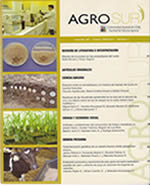Pre-compaction as tool to improve water/air relationship in soil reclamation after subsurface sand strata extraction
Main Article Content
Abstract
In order to reclaim a disturbed Inceptisol (1 m depth, sandy loam) after subsurface sand extraction, pre-compaction labours with different water contents were made, to assess the impact of this management on some soil physical properties. Randomized field plots (20 m2) were used to achieve three increasing pre-compaction levels (T1, T2 and T3) and a control without compaction (T0), considering four replicates. A pea crop (Pisum sativum L.) was established as biological indicator. Bulk density, water content, pre-compaction by Proctor test (laboratory and field), infiltration rate and resistance to penetration were measured in the soil, while dry matter was measured in the crop. Soil bulk density values ranged between 1.25 Mg m-3 for T0 and 1.49 Mg m-3 for T3, the higher precompaction treatment. Field Proctor test showed results similar to those found in the laboratory assessment, with a parabolic adjustment pattern. Soil resistance to penetration reached maximum values fluctuating between 180 and 280 kPa, concentrating in the surface and dissipating below 30 cm depth. Increased water storage was generated by pre-compaction treatments, although T3 promoted a significantly lower infiltration rate. The best crop yield was observed in T2, with a bulk density of 1.41 Mg m-3, showing the best water/air/ resistance relation which resulted in a higher crop yield.

